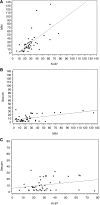Proliferation marker securin identifies favourable outcome in invasive ductal breast cancer
- PMID: 18594525
- PMCID: PMC2480969
- DOI: 10.1038/sj.bjc.6604475
Proliferation marker securin identifies favourable outcome in invasive ductal breast cancer
Abstract
We introduce a new proliferation marker, securin (pituitary tumour-transforming 1 (PTTG1)), analysed in invasive ductal breast carcinomas by cDNA microarrays and immunohistochemistry. In cDNA microarray of a total of 4000 probes of genes, securin was revealed with a significant change in expression among the several proliferation-related genes studied. The value of securin as a proliferation marker was verified immunohistochemically (n=44) in invasive ductal breast cancer. In follow-up analyses of the sample of patients, the prognostic value of securin was compared with the established markers of breast cancer proliferation, Ki-67 and mitotic activity index (MAI). Our results of a small sample of patients suggest that low securin expression identifies a distinct subgroup of more favourable outcome among patients with high Ki-67 immunoexpression or high MAI. In univariate analysis of Cox's regression, 10-unit increment of securin immunopositivity was associated with a 2.3-fold overall risk of death due to breast cancer and a 7.1-fold risk of death due to breast cancer in the sample of patients stratified according to the cutoff points of 10 and 20% of securin immunopositivity. We suggest that securin immunostaining is a promising and clinically applicable proliferation marker. The finding urges further prognostic studies with a large sample of patients.
Figures



Similar articles
-
Securin promotes the identification of favourable outcome in invasive breast cancer.Br J Cancer. 2009 Sep 15;101(6):1005-10. doi: 10.1038/sj.bjc.6605237. Epub 2009 Aug 18. Br J Cancer. 2009. PMID: 19690544 Free PMC article.
-
Securin is overexpressed in breast cancer.Mod Pathol. 2005 Jul;18(7):985-90. doi: 10.1038/modpathol.3800382. Mod Pathol. 2005. PMID: 15846392
-
Low cdc27 and high securin expression predict short survival for breast cancer patients.APMIS. 2013 Oct;121(10):945-53. doi: 10.1111/apm.12110. Epub 2013 Jun 12. APMIS. 2013. PMID: 23755904
-
PTTG1-interacting protein (PTTG1IP/PBF) predicts breast cancer survival.BMC Cancer. 2017 Oct 27;17(1):705. doi: 10.1186/s12885-017-3694-6. BMC Cancer. 2017. PMID: 29078751 Free PMC article.
-
Gene expression profiling revealed MCM3 to be a better marker than Ki67 in prognosis of invasive ductal breast carcinoma patients.Clin Exp Med. 2020 May;20(2):249-259. doi: 10.1007/s10238-019-00604-4. Epub 2020 Jan 24. Clin Exp Med. 2020. PMID: 31980982
Cited by
-
Pituitary tumor-transforming gene 1 is expressed in primary ductal breast carcinoma, lymph node infiltration, and distant metastases.Dis Markers. 2013;35(4):267-72. doi: 10.1155/2013/912304. Dis Markers. 2013. PMID: 24344401 Free PMC article.
-
A prognostic model based on cell-cycle control predicts outcome of breast cancer patients.BMC Cancer. 2020 Jun 16;20(1):558. doi: 10.1186/s12885-020-07045-3. BMC Cancer. 2020. PMID: 32546141 Free PMC article.
-
Cdc20 and securin overexpression predict short-term breast cancer survival.Br J Cancer. 2014 Jun 10;110(12):2905-13. doi: 10.1038/bjc.2014.252. Epub 2014 May 22. Br J Cancer. 2014. PMID: 24853182 Free PMC article.
-
Securin promotes the identification of favourable outcome in invasive breast cancer.Br J Cancer. 2009 Sep 15;101(6):1005-10. doi: 10.1038/sj.bjc.6605237. Epub 2009 Aug 18. Br J Cancer. 2009. PMID: 19690544 Free PMC article.
-
Extensive review on breast cancer its etiology, progression, prognostic markers, and treatment.Med Oncol. 2023 Jul 14;40(8):238. doi: 10.1007/s12032-023-02111-9. Med Oncol. 2023. PMID: 37442848 Review.
References
-
- Baak JP, van Diest PJ, Voorhorst FJ, van der Wall E, Beex LV, Vermorken JB, Janssen EA, Gudlaugsson E, other collaborators of the Multicenter Morphometric Mammary Carcinoma Project (MMMCP) (2007) The prognostic value of proliferation in lymph-node-negative breast cancer patients is age dependent. Eur J Cancer 43: 527–535 - PubMed
-
- Baak JPA, van Dop H, Kurver PHJ, Hermans J (1985) The value of morphometry to classic prognosticators in breast cancer. Cancer 56: 374–382 - PubMed
-
- Bernal JA, Luna R, Espina A, Lazaro I, Ramos-Morales F, Romero F, Arias C, Silva A, Tortolero M, Pintor-Toro JA (2002) Human securin interacts with p53 and modulates p53-mediated transcriptional activity and apoptosis. Nat Genet 32: 306–311 - PubMed
-
- Desmedt C, Sotiriou C (2006) Proliferation: the most prominent predictor of clinical outcome in breast cancer. Cell Cycle 5: 2198–2202 - PubMed
Publication types
MeSH terms
Substances
LinkOut - more resources
Full Text Sources
Medical

